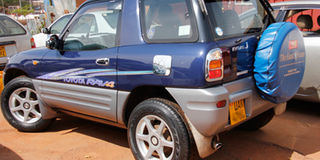How is the first RAV4?

The first generation Toyota RAV4 is still popular among some Ugandans. The RAV4 is now in its fourth generation. PHOTO BY ABUBAKER LUBOWA.
I am one of your followers and thanks for the good work in the magazine. I drive a 2.0 litre Toyota RAV4 made in 1995 with a manual transmission and it is still in a good condition. However, I would like to change to a newer model which is not expensive and easy to maintain. Do the newer model RAV4s perform better than mine and are they as easy to maintain and reliable on our on and off road conditions?
Joshua (Kabale).
The Toyota RAV4 performance standards in your case seem to be set by your driving needs, road conditions and maintenance capability. However, in broad terms the newer a vehicle the better it should be because of improvements that are built in to enhance vehicle performance (responsiveness, fuel economy and handling), vehicle safety features (Anti-lock brakes, Stability control programmes and supplementary restraint air bags), comfort and convenience as well as aesthetics or ambience (looks).
A comparison in performance terms, of your 1995 2.0 litre RAV4 with the two newer generations the 2000 model year 2.0 litre VVTi with D4 and the 2010 model year 2.0 litre valvematic with the CVT (Continuous Velocity Transmission) will put the 1995 RAV5 at the bottom of the ladder.
The 1995 RAV4 with the 2.0 litre petrol 3SFE MPI engine is weaker (129 horse power), slower (takes 11.6 seconds to accelerate 0-100 kph) with a poorer fuel economy (10.63 km/l highway). The 2000 model VVTi (Variable Valve Timing intelligent) with D4 delivers a higher engine output of 150 HP, takes 10.6 seconds to accelerate from 0-100kph and is more economical with fuel on the highway: 13.6 KM/L. The 2010 model RAV4 with a 2.0 litre engine delivers the highest engine output of 158 HP, is the fastest (0-100 kph in 10.2 seconds) and is the most fuel efficient (16.1 KM/L on the highway).
Ease of maintenance depends on your commitment and ability (affordability and availability) to maintain the car. The newer Toyota RAV4 engines are more intolerant to poor quality fuel and lubricants and will breakdown sooner if you do not adhere to the periodic maintenance or service schedule with genuine Toyota parts.
Admittedly some of their engine, suspension and body parts are also more expensive and only readily available around Kampala with genuine Toyota dealers. This tends to make the 1995 Toyota RAV4 easier to maintain and a ‘workhorse’ which can survive on some of our harsh upcountry roads.
However, the 1995 RAV4 also needs to be periodically maintained i.e. change of spark plugs, fuel filter and air cleaner with good reputable lubricants and fuel because it is not an indestructible trojan horse. Off road prowess of the three RAV4s is questionable because they are just recreational vehicles for medium off road terrain and not built as tough as the bigger and heavier Land Cruiser.
I hope all is well. I bought a Toyota Gaia off the Internet and it arrived in Uganda in May. I have not had any problem with it so far but I was wondering why it takes a few seconds to start in the morning or when I park it all day at work. Could it be that it stays outside since I have no garage yet? You know most times, it rains and it gets really cold.Please advise me on what to do to avoid any further problems. Kind regards, Charlotte.
You need a mechanic to check the throttle valve and attached idle air control valve which may be malfunctioning because of accumulated gunk (carbon deposit build up) from the engine blow by gases escaping through the positive crank case ventilator valve.
The throttle valve (butter fly valve) which is housed in the throttle body and the attached idle air control valve are positioned along the air intake chamber. In your electronic fuel injected car the throttle valve is controlled by the engine computer. The throttle and idle air control valves regulate air intake into the engine, determining the charge (ratio of air and fuel) which is crucial for quick cold starts, efficient engine running and emission control.
Accumulation of gunk will prevent the above functions and cause hard cold starts and efficient engine running, however this can be cleaned using a good carburettor cleaner. Also ask the mechanic to carry out a routine inspection or replacement of the fuel filter, spark plugs and air cleaner because a strong spark and unrestricted supply of clean fuel and air are necessary prerequisites for a prompt engine cold start.




